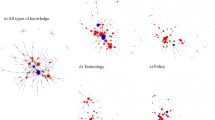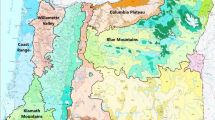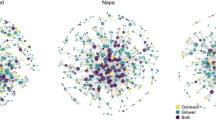Abstract
While it is well documented that informal social ties play a role in information exchange on land management practices, the structural features of such networks that govern individual choice on land use change remain elusive. This study aims to correlate information network structures with localized or “micro-level” land use diversification and land use change. We ask the following: (i) what is the network structure of producers who manage diverse land use types? and (ii) are network topologies and the emergence of new network ties related to land use change? This work draws on a longitudinal study with producers in the transition zone of Ghana. We use social network analysis to assess the social relationships of 40 focal producers embedded in networks of 116 producers, combined with field observation to chart land use types and size. Land use ordered across eight types, from forest and agroforests to crops and grasslands. Converting land to crop production was correlated to the addition of ties in a focal producer’s network, while the diversity of land use types was correlated to the number of institutional ties as well as gender of the focal producer. We illustrate that local networks relate to land use change whereas external ties drive the introduction of new land use types. Given that the diversity of land use types may be a signature of livelihood resilience, the promotion of external, bridging ties can contribute to an increase in land use diversification. However, a strong local network is needed to implement this change.

Similar content being viewed by others
References
Aalders I (2008) Modeling land-use decision behavior with Bayesian belief networks. Ecol Soc 13(1):16 [online] URL: http://www.ecologyandsociety.org/vol13/iss1/art16/
Abson DJ, Fraser ED, Benton TG (2013) Landscape diversity and the resilience of agricultural returns: a portfolio analysis of land-use patterns and economic returns from lowland agriculture. Agric Food Sec 2:1–15. doi:10.1186/2048-7010-2-2
Adjei-Nsiah S, Leeuwis C, Sakyi-Dawson O, Giller KE, Kuyper TW (2008) Exploring diversity among farmers for orienting interdisciplinary action research on cropping system management in Wenchi, Ghana: the significance of time horizons. Int J Agr Sustain 5:176–194. doi:10.1080/14735903.2007.9684821
Adjei-Nsiah S, Issaka RN, Mapfumo P, Anchirana V, Giller KE (2010) Farmers’ perceptions of climate change variability and existing opportunities for adaptation in Wenchi area of Ghana. J Climate change-Impacts and Response 2:49–60. doi:10.18848/1835-7156/CGP/v02i02/37311
Angst M, Hirschi C (2016) Network dynamics in natural resource governance: a case study of Swiss landscape management. Policy Stud J, early view. DOI:10.1111/psj.12145
Bodin O, Crona B, Ernstson H (2006) Social networks in natural resource management—what’s there to learn from a structural perspective? Ecol Soc 11(2):r2 [online] URL: http://www.ecologyandsociety.org/vol11/iss2/resp2/
Bodin O, Crona B (2009) The role of social networks in natural resource governance: what relational patterns make a difference? Glob Environ Chang 19:366–374. doi:10.1016/j.gloenvcha. 2009.05.002
Brown DG, Page SE, Riolo R, Zellner M, Rand W (2005) Path dependence and the validation of agent-based spatial models of land use. Int J Geogr Inf Sci 19:153–174. doi:10.1080/13658810410001713399
Burt RS (1995) Structural holes: the social structure of competition. Harvard University Press, Cambridge
Cadger K, Quaicoo AK, Dawoe D, Isaac ME (2016) Development interventions and agriculture adaptation: a social network analysis of farmer knowledge transfer in Ghana. Agriculture 6:32. doi:10.3390/agriculture 6030032
Crona B, Bodin O (2006) What you know is who you know? Communication patterns among resource users as a prerequisite for co-management. Ecol Soc 11(2):7 [online] URL: http://www.ecologyandsociety.org/vol11/iss2/art7/
Djagbletey GD, Adu-Bredu S (2007) Adoption of agroforestry by small scale teak farmers in Ghana—the case of Nkoranza District. Ghana J For 20:1–13
Demiryurek K (2010) Analysis of information systems and communication networks for organic and conventional hazelnut producers in the Samsun province of Turkey. Agric Syst 103:444–452. doi:10.1016/j.agsy. 2010.04.002
Di Falco S, Perrings C (2005) Crop biodiversity, risk management and the implications of agricultural assistance. Ecol Econ 55(4):459–466. doi:10.1016/j.ecolecon.2004.12.005
Elmqvist T, Folke C, Nystrom M, Peterson G, Bengtsson J, Walker B et al (2003) Response diversity, ecosystem change, and resilience. Front Ecol Environ 1:488–494. doi:10.1890/1540-9295(2003)001[0488:RDECAR]2.0.CO;2
Etwire PM, Dogbe W, Wiredu AN, Martey E, Etwire E, Owusu RK, Wahaga E (2013) Factors influencing farmer’s participation in agricultural projects: the case of the agricultural value chain mentorship project in the northern region of Ghana. J Econ Sustain Dev 4:36–43
Evans TP, Kelley H (2004) Multi-scale analysis of a household level agent-based model of landcover change. J Environ Manag 72:57–72. doi:10.1016/j.jenvman.2004.02.008
Fahrig L, Baudry J, Brotons L, Burel FG, Crist TO et al (2011) Functional landscape heterogeneity and animal biodiversity in agricultural landscapes. Ecol Lett 14:101–112. doi:10.1111/j.1461-0248.2010.01559.x
Foley JA, DeFries R, Asner GP, Barford C, Bonan G, Carpenter SR, Chapin FS, Coe MT, Daily GC, Gibbs HK, Helkowski JH, Holloway T, Howard EA, Kucharik CJ, Monfreda C, Patz JA, Prentice IC, Ramankutty N, Snyder PK (2005) Global consequences of land use. Science 309:570–574. doi:10.1126/science.1111772
Gibbs HK, Ruesch AS, Achard MK, Clayton MK, Holmgren P, Ramankutty N, Foley A (2010) Tropical forests were the primary sources of new agricultural land in the 1980s and 1990s. Proc Natl Acad Sci 107:16732–16737. doi:10.1073/pnas.0910275107
Grau HR, Aide M (2008) Globalization and land-use transitions in Latin America. Ecol Soc 13(2):16 [online] URL: http://www.ecologyandsociety.org/vol13/iss2/art16/
Grau HR, Kuemmerle T, Macchi L (2013) Beyond ‘land sparing versus land sharing’: environmental heterogeneity, globalization and the balance between agricultural production and nature conservation. Curr Opin Environ Sustain 5:477–483. doi:10.1016/j.cosust.2013.06.001
Griffin JN, O’Gorman EJ, Emmerson MC, Jenkins SR, Klein A-M, Loreau M, Symstad A (2009) Biodiversity and the stability of ecosystem functioning. In: Naeem S, Bunker DE, Hector A, Loreau M, Perrings C (eds) Biodiversity, ecosystem functioning, and human wellbeing-an ecological and economic perspective. Oxford University Press, Oxford, pp 78–93
Hanneman RA, Riddle M (2005) Introduction to social network methods. University of California, Riverside, Riverside, CA
Hersperger AM, Gennaio M, Verburg PH, Bürgi M (2010) Linking land change with driving forces and actors: four conceptual models. Ecol Soc 15(4):1 [online] URL: http://www.ecologyandsociety.org/vol15/iss4/art1/
Hoang LA, Castella JC, Novosad P (2006) Social networks and information access: implications for agricultural extension in a rice farming community in northern Vietnam. Agric Human Values 23:513–527. doi:10.1007/s10460-006-9013-5
Isaac ME (2012) Agricultural information exchange and organizational ties: the effect of network topology on managing agrodiversity. Agric Syst 109:9–15. doi:10.1016/j.agsy.2012.01.011
Isaac ME, Erickson B, Quashie-Sam J, Timmer VR (2007) Transfer of knowledge on agroforestry management practices: structure of informal advice networks. Ecol Soc 12(2):32 [online] URL: http://www.ecologyandsociety.org/vol12/iss2/art32/
Isaac ME, LCN A, Akoto DS, Dawoe E (2014) Migrant farmers as information brokers: agroecosystem management in the transition zone of Ghana. Ecol Soc 19(2):56. doi:10.5751/ES-06589-190256
Kadushin C (2012) Understanding social networks: theories, concepts, and findings. Oxford University Press, Oxford
Klasen SJ, Priebe RR (2013) Cash crop choice and income dynamics in rural areas: evidence for post-crisis Indonesia. Agric Econ 44:349–364. doi:10.1111/agec.12015
Klerkx L, Aarts N, Leeuwis C (2010) Adaptive management in agricultural innovation systems: the interactions between innovation networks and their environment. Agric Syst 103:390–400. doi:10.1016/j.agsy.2010.03.012
Lambin EF, Meyfroidt P (2010) Land use transitions: socio-ecological feedback versus socio-economic change. Land Use Policy 27:108–118. doi:10.1016/j.landusepol.2009.09.003
Lambin EF, Geist H, Lepers E (2003) Dynamics of land use and cover change in tropical regions. Annu Rev Environ Resour 28:205–241. doi:10.1146/annurev.energy.28.050302.105459
Lubell M, Hillis V, Hoffman M (2011) Innovation, cooperation, and the perceived benefits and costs of sustainable agriculture practices. Ecol Soc 16(4):23. doi:10.5751/ES-04389-160423
Marull J, Tello E, Wilcox PT, Coll F, Pons M, Warde P, Valldeperas N, Olles A (2014) Recovering the land-use history behind a Mediterranean edge environment (the Congost Valley, Catalonia, 1854–2005): the importance of agroforestry systems in biological conservation. Appl Geogr 54:1–17. doi:10.1016/j.apgeog.2014.06.030
Matous P, Todo Y (2015) Exploring dynamic mechanisms of learning networks for resource conservation. Ecol Soc 20(2):36. doi:10.5751/ES-07602-200236
Matous P, Todo Y, Ishikawa T (2014) Emergence of multiplex mobile phone communication networks across rural areas: an Ethiopian experiment. Netw Sci 2:162–188. doi:10.1017/nws.2014.12
Matous P (2015) Social networks and environmental management at multiple levels: soil conservation in Sumatra. Ecol Soc 20(3):37. doi:10.5751/ES-07816-200337
Matuschke I (2008) Evaluating the impact of social networks in rural innovation systems. International Food Policy Research Institute, Washington
Munroe DK, van Berkel DB, Verburg PH, Olson JL (2013) Alternative trajectories of land abandonment: causes, consequences and research challenges. Curr Opin Environ Sustain 5:471–476. doi:10.1016/j.cosust.2013.06.010
Plieninger T, Schaar M (2008) Modification of land cover in a traditional agroforestry system in Spain: processes of tree expansion and regression. Ecol Soc 13(2):25 [online] URL: http://www.ecologyandsociety.org/vol13/iss2/art25/
Prell C, Hubacek K, Reed M (2009) Stakeholder analysis and social network analysis in natural resource management. Soc Natur Resour 22:501–518. doi:10.1080/08941920802199202
Rindfuss RR, Entwisle B, Walsh SJ, An L, Badenoch N, Brown DG, Deadman P, Evans TP, Fox J, Geoghegan J, Gutmann M, Kelly M, Linderman M, Liu J, Malanson GP, Mena CF, Messina JP, Parker DC, Robinson D, Sawangdee Y, Verburg P, Zhong G (2008) Land use change: complexity and comparisons. J Land Use Sci 3:1–10. doi:10.1080/17474230802047955
Rogers EM (2003) Diffusion of innovations, fifth edn. Free Press, New York
Rudel TK (2006) Shrinking tropical forests, human agents of change, and conservation policy. Conserv Biol 20:1604–1609. doi:10.1111/j.1523-1739.2006.00532.x
Rudel TK (2009) How do people transform landscapes? A sociological perspective on suburban sprawl and tropical deforestation. Am J Sociol 115:129–154. doi:10.1086/597794
Sandström A, Carlsson L (2008) The performance of policy networks: the relation between network structure and network performance. Policy Stud J 36:497–525. doi:10.1111/j.1541-0072.2008.00281.x
Spielman DJ, Ekboir J, Davis K (2009) The art and science of innovation systems inquiry: applications to sub-Saharan African agriculture. Tech Soc 31(4):399–405. doi:10.1016/j.techsoc.2009.10.004
Swift MJ, AMN I, van Noordwijk M (2004) Biodiversity and ecosystem services in agricultural landscapes: are we asking the right questions? Agric Ecosyst Environ 104:113–134. doi:10.1016/j.agee.2004.01.013
Thuo M, Bell AA, Bravo-Ureta BE, Lachaud MA, Okello DK, Okoko EN, Kidula NL, Deom CM, Puppala N (2014) Effects of social network factors on information acquisition and adoption of improved groundnut varieties: the case of Uganda and Kenya. Agric Human Val 31:339–353. doi:10.1007/s10460-014-9486-6
Tscharntke T, Tylianakis JM, Rand TA, Didham RK, Fahrig L, Batary P, Bengtsson J, Clough Y, Crist TO, Dormann CF, Ewers RM, Frund J, Holt RD, Holzschuh A, Klein AM, Kleijn D, Kremen C, Landis DA, Laurance W, Lindenmayer D, Scherber C, Sodhi N, Steffan-Dewenter I, Thies C, van der Putten WH, Westphal C (2012) Landscape moderation of biodiversity patterns and processes—eight hypotheses. Biol Rev 87:661–685. doi:10.1111/j.1469-185X.2011.00216.x
Turner MG (2010) Disturbance and landscape dynamics in a changing world. Ecology 91:2833–2849. doi:10.2307/20788110
Van der Geest K (2011) North-south migration in Ghana: what role for the environment? Int Mig 49:69–94. doi:10.1111/j.1468-2435.2010.00645.x
Wasserman S, Faust K (1994) Social networks analysis: methods and applications. Cambridge University Press, Cambridge
Wymen MS, Stein TV (2010) modeling social and land-use/land-cover change data to assess drivers of smallholder deforestation in Belize. Appl Geogr 30:329–342. doi:10.1016/j.apgeog.2009.10.001
Acknowledgements
We thank all participants in this research as well as W. Ampofo and K. Cadger for field assistance. We thank anonymous journal reviewers for the insightful and important comments on earlier versions of this paper. This research was financially supported by the Canada Research Chairs program and a Social Sciences and Humanities Research Council of Canada Insight Development Grant to MEI.
Author information
Authors and Affiliations
Corresponding author
Ethics declarations
This research received ethics approval from the Social Sciences, Humanities and Education Research Ethics Board, University of Toronto, for research involving human participants. Informed consent was secured in advance of every interview.
Additional information
Editor: Christopher Reyer.
Rights and permissions
About this article
Cite this article
Isaac, M., Matous, P. Social network ties predict land use diversity and land use change: a case study in Ghana. Reg Environ Change 17, 1823–1833 (2017). https://doi.org/10.1007/s10113-017-1151-3
Received:
Accepted:
Published:
Issue Date:
DOI: https://doi.org/10.1007/s10113-017-1151-3




